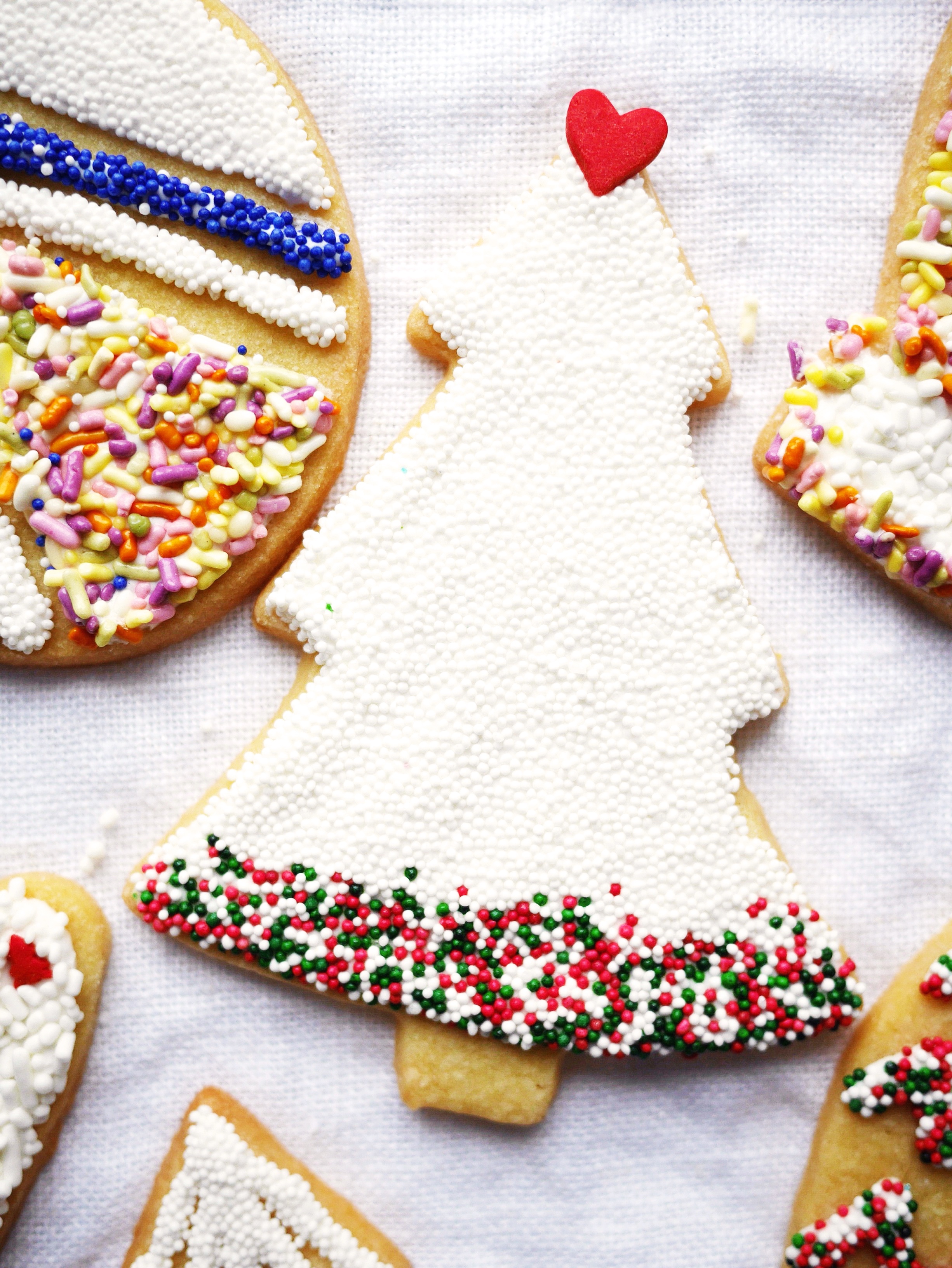If this were another blog, the title of this post would probably be "On overcoming personal struggles and learning to live a new life" or something along those lines. But, since it's a food site, there's a cookie recipe with a side of life lessons.
On a chilly Friday in February one year ago, I was living in Manhattan, working at Real Simple, and making recipes that appealed to the magazine’s broad demographic (aka delicious crowdpleasers). But most importantly, I had the first in a series of year-long, debilitating chronic migraines. Thus began an arduous journey to get to the bottom of the headaches. I tried my traditional method of strong-arming my way towards success, but as anyone who’s had a migraine knows, that just doesn’t work. I waited for the pain to pass, but day in and day out, it kept me company like the worst of frenemies. I couldn’t kick it.
If you had told me then, that twelve months later I would be sitting at home in Brooklyn, working freelance, mostly migraine-free, and baking a celebration miso cookie (read: non crowd-pleaser), I couldn’t have believed it. It’s been a long journey, filled with about 40 different doctors and a lot of biofeedback and acupuncture, but I’m finally here, cookies in hand.
I’m still figuring out how to write about the past year. As I process it, I keep returning to my favorite passage at the end of Wild, Cheryl Strayed’s memoir about hiking the Pacific Crest Trail. (Wild is in theaters, now, and it’s fantastic, but I recommend reading the book first as well as Tiny Beautiful Things, Strayed’s compilation of her incredible Dear Sugar columns.) Skip ahead if you don’t want to read the last few paragraphs of Wild. She writes:
“After he drove away, I leaned my head back and closed my eyes against the sun as the tears I’d expected earlier at the bridge began to seep from my eyes. Thank you, I thought over and over again. Thank you. Not just for the long walk, but for everything I could feel finally gathered up inside of me; for everything the trail had taught me and everything I couldn’t yet know, though I felt it somehow already contained within me. How I’d never see the man in the BMW again, but how in four years I’d cross the Bridge of the Gods with another man and marry him in a spot almost visible from where I now sat. How in nine years that man and I would have a son named Carver, and a year and a half after that, a daughter named Bobbi. How in fifteen years I’d bring my family to this same white bench and the four of us would eat ice-cream cones while I told them the story of the time I’d been here once before, when I’d finished walking a long way on something called the Pacific Crest Trail…“...It was all unknown to me then, as I sat on that white bench on the day I finished my hike. Everything except the fact that I didn’t have to know. That it was enough to trust that what I’d done was true. To understand its meaning without yet being able to say precisely what it was, like all those lines from The Dream of a Common Language that had run through my nights and days. To believe that I didn’t need to reach with my bare hands anymore. To know that seeing the fish beneath the surface of the water was enough. That it was everything. It was my life—like all lives, mysterious and irrevocable and sacred. So very close, so very present, so very belonging to me.“How wild it was, to let it be.”
I went through a lot of ups and downs adjusting to self-employment and trying to get over migraines, days where I hardly left the apartment and worked in complete solitude, or days where I was in too much pain to get up. But, as I struggled to find answers, I found the capacity for a new level of creativity, the ability to jettison fear, a new habit of welcoming the unpredictable (both miso cookies and health setbacks alike) and living with joy.
So, I’m celebrating in my favorite way, by baking. I wanted to make something weird and out of the ordinary, like my past year. These began as a haywire riff on my oatmeal raisin recipe, eventually turning into a kooky distant relative that boasts a hit of umami-rich miso, and a mix of whole grains, nuts, and seeds.
One bite vibrates with rich flavors: dark brown sugar and dried apricots boost the caramel undertones while sesame seeds and roasted pistachios amplify the miso’s nuttiness. This unusual cookie is not going to be everyone’s favorite, but it might knock the socks off a few tasters.
Cheers!
Chunky Whole-Grain and Miso Cookies Recipe by Lindsay Hunt
Makes 2 dozen cookies
Ingredients: 1 cup whole wheat bread flour (140g) or: use 1 ¾ cups whole wheat or all-purpose flour in place of the bread and cake flours) ¾ cup cake flour (96g) ¾ cup wheat bran (37g) 1 teaspoon baking soda 1 pinch fine salt 2 teaspoons ground ginger 1 cup toasted chopped pistachios, chopped ½ cup old-fashioned rolled oats (150g) 1 cup dried apricots, chopped (260g) ¼ cup white or black sesame seeds (or a mixture of both), plus additional for sprinkling 2 sticks (1 cup) unsalted butter, at room temperature 1 cup packed dark brown sugar (200g) 3/4 cup granulated sugar (170g) 2 tablespoons white miso paste 2 large eggs plus one egg yolk (for garnish), at room temperature 1 teaspoon pure vanilla extract
Equipment: Two baking sheets, ideally without rims, parchment paper or nonstick cooking mats such as silpat, an airtight container to store the cookie dough in, and a digital scale (if you have one)
Combine the flours, bran, baking soda, salt, and ginger in a medium bowl. Whisk until thoroughly combined. Stir in the oats, pistachios, sesame seeds, and apricots; set aside
Place the butter, sugars, and miso in the bowl of a stand mixer fitted with the paddle attachment (or use a hand mixer). Cream on medium-high speed until light and fluffy, 3 to 4 minutes. Stop the mixer occasionally and scrape down the sides and paddle with a rubber spatula.
Add the two whole eggs and vanilla and mix on medium speed until well combined, about 1 minute. Add the flour mixture and mix on low speed until just combined, about 30 seconds.
Transfer the dough to an airtight container and refrigerate at least 2 hours, but preferably 24 to 72 hours.
30 minutes before baking, preheat the oven to 350º F. Line two baking trays with parchment paper or silicone mats.
Portion the dough into 2-ounce (55 gram/2 heaping tablespoon) scoops. Roll gently with your hands into balls. Space the dough 3 inches apart on each tray, about 8 to a tray. Flatten gently with your hand.
Brush the remaining egg yolk onto the prepared cookies, dividing evenly. Sprinkle with additional sesame seeds.
Bake for 18 to 22 minutes, rotating the trays front to back and top to bottom halfway through. Pull the cookies out when they look just set—they will continue to cook when they come out of the oven. They will not be mostly blonde with small spots of golden brown. They will turn completely golden brown as they cool on the cookie sheets. (**Timing may vary based on the size of your cookies, how cold the dough is, and your oven.)
Cool the cookies on the sheets for 5 minutes, then transfer to a wire rack to cool completely. Cookies will keep in an airtight container for up to 3 days.
Goodbye from the bottom of this seed-studded cookie!







